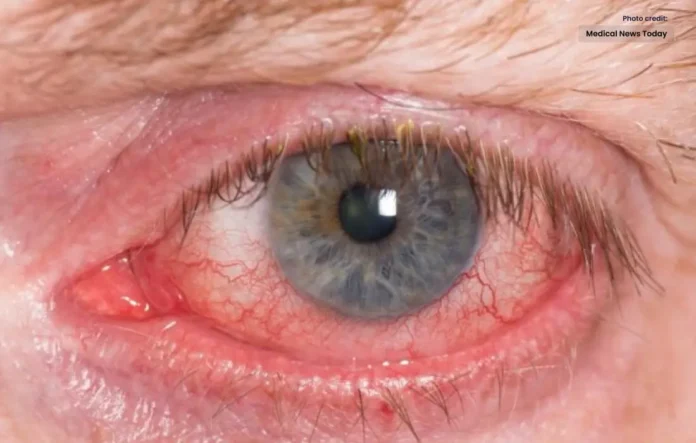Glaucoma is a disease that is becoming more common in recent times.
Glaucoma is a disease that is becoming more common in recent times. One of the reasons the disease is so widespread is that it often starts without any symptoms and is not known until the affected person loses their sight.
And this is the reason why it is not possible to restore sight after the disease progresses but what are the symptoms of this mysterious disease and how can they be checked in the early stages?
Read More Informative Articles in Urdu
What is Glaucoma?
Glaucoma is a disease that affects the eyes. This disease affects the nerves that connect the eyes to the brain.
According to the British health service NHS, it is caused by fluid that collects in the eye and puts pressure on the nerves and damages them.
Glaucoma sufferers start having vision problems and if not diagnosed and treated at an early stage, vision can be lost completely.
This disease affects people of almost all ages, but the risk of this disease is higher in people aged 70 to 80 years. What are the symptoms of glaucoma?
One of the complications associated with this disease is that there are no obvious symptoms in the early stages, so it can only be diagnosed through experiments.
Over time, the severity of the disease increases, which affects the vision.
There is even a time when the victim cannot see anything near him. Complaints of blurred vision or seeing rainbow-like rings around light are some of the symptoms of glaucoma.
Glaucoma Types:
- Primary Open-Angle Glaucoma (POAG): The most prevalent kind of glaucoma is this one. It takes time to grow and may not show any symptoms until serious damage has been done.
- Angle-Closure Glaucoma: This kind causes an abrupt rise in intraocular pressure (IOP) by obstructing the eye’s drainage angle. To avoid irreversible eyesight loss, medical attention must be sought right away.
- Normal-Tension Glaucoma: This kind of glaucoma results in optic nerve damage even in the presence of normal IOP levels.
- Secondary Glaucoma: This kind arises from other eye disorders or diseases, such as tumors, inflammations, or trauma to the eyes.
Glaucoma symptoms include:
Early on in its progression, glaucoma frequently shows no symptoms at all. But when the illness worsens, people could encounter:
- Progressive blindness in the periphery
- Hazy vision
- Haloes surrounding lights
- Intense discomfort in the eyes
- Vomiting and nausea (in cases of acute angle-closure)
Frequent eye exams are essential for the early diagnosis and treatment of glaucoma, particularly in higher-risk individuals such as those with a family history of the disease, those over 60, and those with certain medical disorders like diabetes.
Diagnose and Therapy:
The key to preventing visual loss from glaucoma is early identification. A thorough examination of the eyes by eye doctors usually includes taking the patient’s intraocular pressure, looking at the optic nerve, and evaluating their visual field. For a precise diagnosis, other procedures like gonioscopy and optical coherence tomography (OCT) may also be carried out.
The goals of glaucoma treatment are to lower intraocular pressure and stop more optic nerve damage. These could consist of:
- Medication: To reduce intraocular pressure, a doctor may prescribe eye drops, oral drugs, or a mix of the two.
- Laser Therapy: Treatments such as iridotomy or laser trabeculoplasty can enhance the eye’s ability to expel aqueous fluid.
- Surgery: To construct a new fluid drainage conduit, surgical procedures like trabeculectomy or shunt implantation may be advised in situations where drugs and laser therapy are not helpful.
Way of Life and Administration:
Certain lifestyle modifications can assist control and lower the chance of progression in addition to medical treatment:
- Frequent Exercise: Increasing your level of moderate physical exercise can assist your optic nerve’s blood flow.
- Healthy Diet: Eating a diet high in vitamins, minerals, and antioxidants may help maintain general eye health.
- Stress management: Since high levels of stress can raise intraocular pressure, it can be helpful to practice relaxing methods like deep breathing exercises or meditation.
When should glaucoma be treated?
If you have any problems with your vision, it is important to see a doctor immediately.
It is very important to diagnose and treat glaucoma in the early stages, otherwise there is a risk that it will gradually increase in severity and vision may be lost completely.
Therefore, if you feel any of the above symptoms, do not ignore them and go to the hospital immediately.
Conclusion
In order to prevent vision loss, glaucoma is a critical eye condition that needs to be diagnosed and treated right away. People can prevent vision loss and maintain their quality of life by being aware of the causes, symptoms, and available treatment choices. To prevent glaucoma and enable people to keep their eyes healthy for many years to come, routine eye exams and early intervention are essential.
Also read this: What are the Symptoms of Seasonal Allergy?




